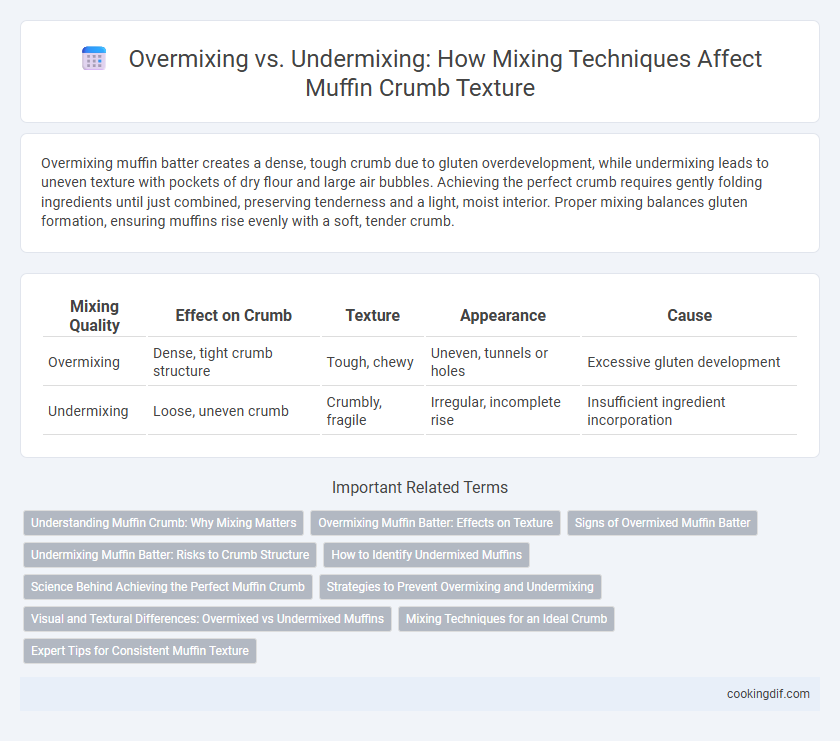Overmixing muffin batter creates a dense, tough crumb due to gluten overdevelopment, while undermixing leads to uneven texture with pockets of dry flour and large air bubbles. Achieving the perfect crumb requires gently folding ingredients until just combined, preserving tenderness and a light, moist interior. Proper mixing balances gluten formation, ensuring muffins rise evenly with a soft, tender crumb.
Table of Comparison
| Mixing Quality | Effect on Crumb | Texture | Appearance | Cause |
|---|---|---|---|---|
| Overmixing | Dense, tight crumb structure | Tough, chewy | Uneven, tunnels or holes | Excessive gluten development |
| Undermixing | Loose, uneven crumb | Crumbly, fragile | Irregular, incomplete rise | Insufficient ingredient incorporation |
Understanding Muffin Crumb: Why Mixing Matters
Overmixing muffin batter develops excess gluten, resulting in a tough, dense crumb, while undermixing leads to uneven texture and pockets of dry flour. Achieving a tender, moist muffin crumb requires gently combining wet and dry ingredients until just incorporated to maintain optimal aeration. Proper mixing balances gluten formation and moisture distribution, crucial for a light, fluffy crumb structure in baked muffins.
Overmixing Muffin Batter: Effects on Texture
Overmixing muffin batter develops excessive gluten, resulting in a dense and tough crumb rather than a light, tender texture. This process traps too much air and causes the batter to deflate during baking, leading to peaked or cracked tops instead of soft, rounded ones. Proper mixing achieves a balance by incorporating ingredients just until combined, ensuring a moist, delicate crumb structure in muffins.
Signs of Overmixed Muffin Batter
Overmixed muffin batter results in a tough, dense crumb with tunnels or holes inside due to excess gluten development. Signs include batter that is overly glossy or sticky and muffins that spring back quickly when touched but feel heavy. Avoid vigorous mixing once the dry ingredients are incorporated to maintain a tender, moist crumb.
Undermixing Muffin Batter: Risks to Crumb Structure
Undermixing muffin batter leads to uneven distribution of ingredients, causing inconsistent crumb texture and dense pockets that compromise the overall lightness. The lack of proper gluten development can result in a crumb that is gummy and heavy rather than tender and airy. Proper mixing ensures homogeneity, promoting a uniform crumb structure essential for optimal muffin quality.
How to Identify Undermixed Muffins
Undermixed muffins typically present with dense, heavy crumbs and uneven texture, often showing pockets of dry flour or streaks within the batter. Identifying undermixed muffins involves noticing coarse, irregular crumb structures and a tendency to crumble or fall apart easily. Proper mixing ensures even distribution of ingredients, so spotting these signs points to insufficient mixing time or technique.
Science Behind Achieving the Perfect Muffin Crumb
Overmixing muffin batter activates excess gluten, resulting in a dense, tough crumb, while undermixing leaves flour pockets that cause an uneven, gummy texture. Achieving a tender crumb requires gentle mixing just until ingredients are combined, balancing gluten development and moisture distribution. Controlled mixing ensures optimal starch gelatinization and gas retention, producing a light, moist crumb with uniform crumb structure.
Strategies to Prevent Overmixing and Undermixing
Careful mixing techniques are essential to achieve the ideal muffin crumb, where overmixing causes tough, dense textures and undermixing leads to uneven crumb structure with pockets of dry flour. To prevent overmixing, fold wet and dry ingredients gently using a spatula until just combined, avoiding electric mixers or vigorous stirring. For avoiding undermixing, ensure all ingredients are fully incorporated with a few light folds, checking for streaks of flour or batter lumps without overworking the batter.
Visual and Textural Differences: Overmixed vs Undermixed Muffins
Overmixed muffins develop a dense, tough crumb with large tunnels and domed tops due to excessive gluten formation. Undermixed muffins display a coarse, uneven crumb with visible pockets of flour and a flat or uneven surface texture. Balanced mixing achieves a tender, moist crumb and uniform crumb structure with a smooth, slightly domed top.
Mixing Techniques for an Ideal Crumb
Proper mixing technique directly influences the muffin crumb texture, balancing gluten development for an ideal outcome. Overmixing causes excessive gluten formation, resulting in a tough, dense crumb, while undermixing leaves pockets of dry ingredients, creating uneven crumb structure. Achieving a tender, light crumb requires gentle folding until just combined, preserving air pockets and ensuring uniform moisture distribution.
Expert Tips for Consistent Muffin Texture
Overmixing muffin batter develops excess gluten, resulting in a dense, tough crumb, while undermixing leads to uneven texture and large air pockets. Expert bakers recommend mixing just until dry ingredients are moistened to achieve a tender, uniform crumb with optimal rise. Using a gentle folding technique helps maintain batter integrity and ensures consistent muffin texture.
Overmixing vs Undermixing for crumb Infographic

 cookingdif.com
cookingdif.com